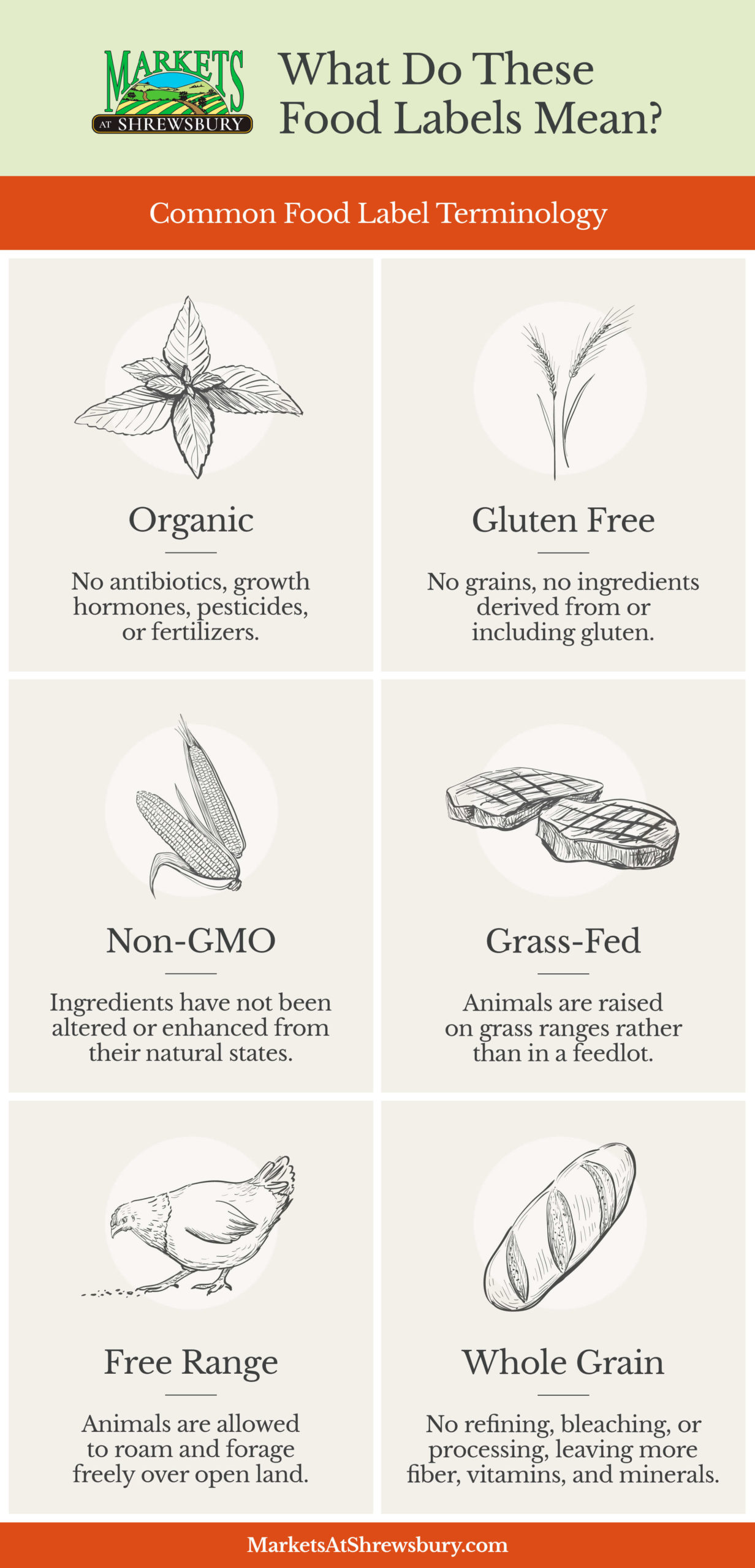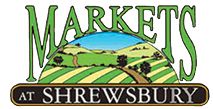You walk into any sort of food store and see stickers slapped onto pretty much every product.
“Fresh, Local, and Organic!” “Naturally gluten-free” “Good source of calcium!” “High in fiber”
But when you browse your local farmers’ market, you can be assured that all the fruit was recently picked, the veggies are fresh, and the baked goods were homemade. In a farmers’ market, there’s no need for most of these labels since there are none of the added ingredients that are used to preserve the products on grocery store shelves. Farmers’ market items have fewer ingredients and more “whole foods” than the selection in your typical grocery store.
If you’re looking to find out what some of those common food labels mean, we’ve put together some tips for figuring it out. Find out how to read foods labeled:
How Do You Interpret Nutrition Facts & Labels?
A majority of these terms are regulated by the FDA or USDA. This means that the food product must meet certain standard requirements to be labeled in that specific way. These claims can be confusing and even misleading at times. Don’t worry, we’ve defined the most common healthy food labels out there to let you know if these are truly beneficial health elements for you and your family.
Click the infographic below to print out our handy guide on “What do these food labels mean?”

1. What Does ‘Organic’ Even Mean?
The U.S. Department of Agriculture has specific guidelines that food producers must comply with if they want to use the “organic” label. Animal products cannot be given antibiotics or growth hormones, and plants cannot be grown with conventional pesticides or fertilizers made with synthetic ingredients or sewage. Genetic engineering and irradiation, exposing crops to radiation to kill bacteria and other pests, are also prohibited for plants to be considered organic.
There are three types of Organic Labels to look for:
- “100% Organic” means products are made entirely from organic ingredients.
- “Organic” means that at least 95 percent of a product’s ingredients are organic.
- “Made with organic ingredients” indicates that at least 70 percent of ingredients are organic.
2. What is Gluten-Free?
In general, foods may be labeled “gluten-free” if the food either is inherently gluten-free or does not contain an ingredient that is a gluten-containing grain. In addition, ingredients that are derived from a gluten-containing grain must be processed in order to remove gluten. After processing gluten-containing grain to remove gluten, the result must be less than 20 parts per million (ppm) of gluten. Any unavoidable presence of gluten in the food must be less than 20 ppm.
3. What Does GMO Even Stand For?
The term, GMO (Genetically Modified Organisms) has become more mainstream and yet most people still don’t know exactly what it means. If you see a product labeled “Non-GMO,” it means the ingredients used have not been altered from their natural state or enhanced.
Genetically modified foods mean that the food’s DNA has been altered with the help of modern technology and as a result, do not have to be labeled. Though GMO-type food’s safety is still up for debate in the scientific community. According to the World Health Organization, GM Foods are not likely to present risks for human health.
The only way to avoid genetically modified foods? Start buying 100 percent organic.

Explore Our Other Blogs
Entertaining & Holidays– Learn how to host perfect dinners and learn about Amish holiday traditions.
In The Kitchen – Explore how to make the most out of your Market’s produce and food with recipes, tips & tricks, helpful guides.
Shopping At The Markets– Find helpful advice for shopping at a farmers market on anything from FAQs on shopping in bulk or secrets to choosing the best produce.
4. What’s the Difference in ‘Grass Fed’ Animals?
By definition, a “grass fed” animal is one that is raised primarily on ranges rather than in a feedlot. Even if the animals are contained, food producers can still show this label, as long as animals are allowed to graze. If an animal was “grain fed,” it was most likely raised in a feedlot, contained for most of its life, and is of less nutritional value. The USDA defines “grass fed” as it applies to labeling but does not regulate it in any way.
5. What Consuming Free Range & Cage Free Food Means
For a product to be labeled “free range” or “cage free,” the animals cannot be contained in any way and must be allowed to roam and forage freely over a large area of open land. This label is very minimally regulated. USDA food labeling regulation only requires that the producer be able to demonstrate that the animals are allowed access to the outside and are not contained, but applications and certification are not required. This level of regulation has allowed producers to keep animals closely confined, but without cages, and still use the label “cage free.”
6. Identifying Whole Grain vs. Multigrain vs. Whole Wheat
Whole grain foods include the bran, nutrient-rich germ, and endosperm of grains such as wheat, oats, or rice. Examples include brown rice, corn, and whole wheat bread. Whole grain foods have more fiber, vitamins, and minerals than processed white grains.
Whole wheat is one type of whole grain. The grains in the product have not been refined or processed. This means it contains more vitamins and nutrients and is all around healthier for you. Not to be confused with 100% wheat, which means the product may have been processed. The golden rule: if the label contains “whole” you’re good to go.
Multigrain means that it contains more than one type of grain, not necessarily the most nutrient kinds; this term is incorrectly interchanged with Whole Grain and Whole Wheat. In reality, Multigrain is the least healthy of the three.
Learn More About Other Nutrition Label Definitions:
- Artificial Flavors vs. Natural Flavors: If you see artificial flavors or flavoring on the box, this is a tip as to how that food gets its taste (and you can bet it did not come from anything that grows in a garden!). This term refers to any flavoring that is not derived from a whole food source, such as a spice, fruit, vegetable, herb, plant material, meat, fish, poultry, etc. Both natural and artificial flavors are made in a lab, but artificial flavoring is created from synthetic rather than natural chemicals. One benefit of choosing natural over artificial is that natural flavors often exist in more nutrient-dense foods.
- Fat-Free, Sugar-Free, Salt-Free: Labeling a food as free of a certain nutrient, whether salt, sugar, or fat, means it has none, or a “physiologically inconsequential” amount of that nutrient, according to the FDA. For sugar or fat, this means the food has fewer than 0.5 grams per serving. But be careful, these “free” foods are often pumped full of other ingredients to make up for lack of taste. A food could say “fat-free,” but could contain a lot of calories from sugar.
- ‘Good Source Of..’: A food with this label should have between 10 to 19 percent of the recommended daily value of a particular vitamin or nutrient per serving.
- ‘High In..’: “High” (or “rich in”) means that the food has 20 percent or more of the recommended daily value for that nutrient per reference serving. This is a larger value than products labeled with “Good source of”.
- Light: Light (or lite) is evaluated in comparison to a reference food, such as comparing Ranch Dressing to Light Ranch. For calories, the “Light” version of the product must have 1/3 to 1/2 calories less than the original recipe. “Lightly salted” should have 50 percent less sodium than its standard version.
- Low-Calorie: Low-calorie is defined as 40 calories or less per serving. If the package says “calorie-free,” the item has fewer than 5 calories per serving.
- Low-Fat, Low-Sugar, or Low-Sodium: If an item is labeled “low” in a particular element, it means that you can eat several servings without exceeding the recommended daily limit.
- Low-fat products have fewer than 3 grams of fat per serving.
- Low-saturated fat items have less than 1 gram per serving.
- Low-sodium means the food has 140 milligrams or less per serving.
- Low-cholesterol means 20 milligrams or less and fewer than 2 grams of saturated fat.
- Natural: The FDA has no formal definition for what “natural” means, but defers to a nearly 20-year-old policy that says it will not object to the label as long as the product “does not contain added color, artificial flavors, or synthetic substances.” There’s no hard and fast definition of it because it’s not regulated by the FDA. Technically speaking, you could print “Natural” on a bag of licorice without being at fault. Just know that natural does not mean healthy in all cases.
- A food labeled natural isn’t necessarily healthier or better for you. After years soliciting suggestions and considering comments on the question of what natural should mean, no useful consensus could be reached, and the FDA decided to forgo establishing an official definition. Though it hasn’t issued rules for the use of natural, it endorses the general understanding that it implies nothing artificial or synthetic has been added that would not normally be expected to be added.
- No Trans Fats: Even if a package advertises “No Trans Fats,” be careful. Products carrying this label can still have up to half a gram of trans fat per serving, according to the FDA. Trans fats are a type of unsaturated fat that raise your LDL cholesterol levels (the bad kind) and increases your risk of heart disease. Because of these health risks, trans fats have been banned or restricted in several cities and counties across the United States.
- Sell By | Use By | Best if Used By: Sell By: For starters, the “sell by” date does not actually concern you, the consumer. It tells the store how long to display the product for sale. Use By: This is the date you should pay the closest attention to. It is the last date recommended for the use of the product while at peak quality and has been determined by the manufacturer of the product. Best if Used By: This is the recommended date for best flavor or quality. It is not a purchase or safety date.



